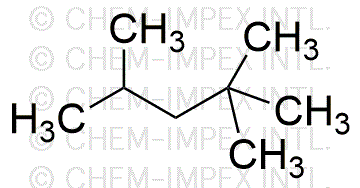2,2,4-Trimethylpentane is widely utilized in research focused on various practical applications:
- Fuel Research: This compound is often used as a reference fuel in octane rating tests, helping researchers evaluate the performance of gasoline and other fuels.
- Solvent Applications: It serves as a solvent in chemical reactions and extractions, providing a non-polar environment ideal for dissolving hydrophobic substances.
- Industrial Lubricants: Its properties make it suitable for formulating high-performance lubricants, enhancing the efficiency and longevity of machinery in automotive and manufacturing sectors.
- Chemical Synthesis: 2,2,4-Trimethylpentane is used as a starting material in the synthesis of various organic compounds, facilitating the production of specialty chemicals.
- Research in Environmental Science: It is employed in studies examining the impact of hydrocarbons on the environment, aiding in the development of cleaner fuel alternatives.
General Information
Properties
Safety and Regulations
Applications
2,2,4-Trimethylpentane is widely utilized in research focused on various practical applications:
- Fuel Research: This compound is often used as a reference fuel in octane rating tests, helping researchers evaluate the performance of gasoline and other fuels.
- Solvent Applications: It serves as a solvent in chemical reactions and extractions, providing a non-polar environment ideal for dissolving hydrophobic substances.
- Industrial Lubricants: Its properties make it suitable for formulating high-performance lubricants, enhancing the efficiency and longevity of machinery in automotive and manufacturing sectors.
- Chemical Synthesis: 2,2,4-Trimethylpentane is used as a starting material in the synthesis of various organic compounds, facilitating the production of specialty chemicals.
- Research in Environmental Science: It is employed in studies examining the impact of hydrocarbons on the environment, aiding in the development of cleaner fuel alternatives.
Documents
Safety Data Sheets (SDS)
The SDS provides comprehensive safety information on handling, storage, and disposal of the product.
Product Specification (PS)
The PS provides a comprehensive breakdown of the product’s properties, including chemical composition, physical state, purity, and storage requirements. It also details acceptable quality ranges and the product's intended applications.
Certificates of Analysis (COA)
Search for Certificates of Analysis (COA) by entering the products Lot Number. Lot and Batch Numbers can be found on a product’s label following the words ‘Lot’ or ‘Batch’.
*Catalog Number
*Lot Number
Certificates Of Origin (COO)
This COO confirms the country where the product was manufactured, and also details the materials and components used in it and whether it is derived from natural, synthetic, or other specific sources. This certificate may be required for customs, trade, and regulatory compliance.
*Catalog Number
*Lot Number
Safety Data Sheets (SDS)
The SDS provides comprehensive safety information on handling, storage, and disposal of the product.
DownloadProduct Specification (PS)
The PS provides a comprehensive breakdown of the product’s properties, including chemical composition, physical state, purity, and storage requirements. It also details acceptable quality ranges and the product's intended applications.
DownloadCertificates of Analysis (COA)
Search for Certificates of Analysis (COA) by entering the products Lot Number. Lot and Batch Numbers can be found on a product’s label following the words ‘Lot’ or ‘Batch’.
*Catalog Number
*Lot Number
Certificates Of Origin (COO)
This COO confirms the country where the product was manufactured, and also details the materials and components used in it and whether it is derived from natural, synthetic, or other specific sources. This certificate may be required for customs, trade, and regulatory compliance.


